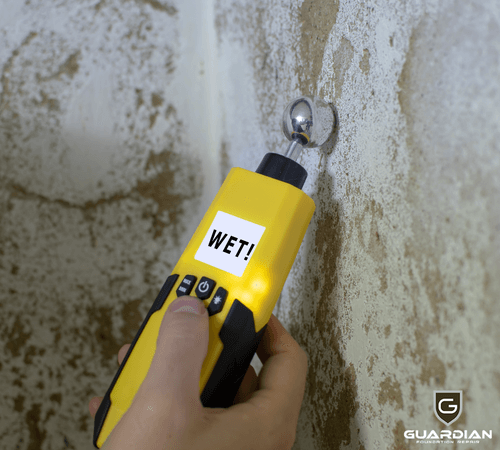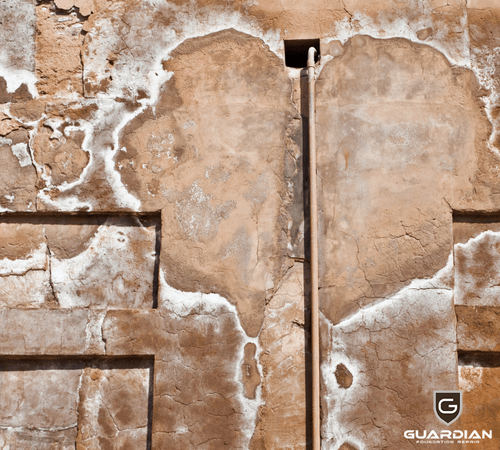Introduction:
You may have seen white stains that randomly appear on bare or painted concrete or block walls in basements. These stains are called efflorescence, a residue of water that appears as white powdery substance on the surface of the concrete.
But what exactly is efflorescence? Why does it happen? And can it be fixed?
Many homeowners in Knoxville and the surrounding areas have reached out to us with these questions. And that’s why our experts at Guardian Foundation Repair have put together this guide to provide a complete understanding of efflorescence and how we can fix it.
What is Efflorescence?
Efflorescence is a powdery salt deposit that appears on the surface of concrete, brick, or stone due to water seepage. When the water evaporates, it leaves behind these salt deposits.
Efflorescence is usually white or light-colored but can also be yellow, brown, or pink. It’s often mistaken for mold because of its fuzzy appearance. Although efflorescence is not harmful or hazardous, it indicates water in your basement walls.
How Does Efflorescence Form?
Efflorescence generally requires three elements to form:
- Salt: The materials used to build walls (brick, stone, or concrete) are made from natural materials containing minerals, with salt being one of them.
- Water: When water seeps into the wall’s surface, it dissolves the salt. But eventually, the water will evaporate, leaving the salt behind, crystallizing, and turning into a powdery substance called efflorescence.
- Cracks: For water to seep in and cause efflorescence, there must be cracks or pores in the wall for the water to enter.
Does Having Efflorescence Means You Have Water Issue in Your Basement?
Efflorescence on your basement wall is a sign of moisture present in your basement. While the efflorescence is not harmful, the water causing it can be.
Water in your basement can lead to severe problems like:
- Foundation cracks
- Mold and mildew growth
- Buckling floors
- Warped walls or ceilings
However, before you conclude that you need basement wall repair to tackle the water issue, you need to know what type of efflorescence you have.
Types of Efflorescence:
There are two types of efflorescence, primary and secondary. Here’s a look at the difference between the two:
Primary Efflorescence:
Primary efflorescence is caused by water that’s present during the curing process of concrete. During this process, water and minerals are drawn to the surface of the concrete, where they evaporate and leave behind a white powdery substance. Primary efflorescence is more common in newly constructed homes as it has not had time to weather and seal properly. However, primary efflorescence is not as severe as secondary and can be removed with a simple cleaning.
Secondary Efflorescence:
Secondary efflorescence is caused by water present after the concrete has cured and is more severe than primary efflorescence. This efflorescence is usually the result of cracks in the foundation or walls that allow water to seep in. Secondary efflorescence is more difficult to remove and usually requires a more powerful cleaning solution or sandblasting.
Secondary efflorescence can sometimes signify a more severe problem, like faulty gutters, a leaking roof, or even poor drainage around your home. If you notice secondary efflorescence, it’s essential to have our foundation repair specialist take a look to determine the cause and make the necessary foundation repairs to your Knoxville home.
How to Fix and Prevent Efflorescence?
Cleaning Efflorescence is only a temporary fix. Water will still be able to enter through the cracks and pores in your foundation and walls, which will cause the efflorescence to come back. To permanently fix efflorescence, you must address the water issue causing it.
So the first thing you need to do is take a walk around your home and check for any cracks or holes in your foundation. If you find any, seal them with hydraulic cement or a masonry sealer.
It’s also essential to ensure that your gutters and downspouts are clean and clear of debris so water can flow freely away from your home. Additionally, you should check the grading around your home to ensure that it slopes away from your foundation so that water doesn’t pool next to your home.
If you still cannot find issues with your gutters, grading, or foundation, you may have a problem with your home’s drainage system or sump pump. In this case, get in touch with a Guardian Foundation Repair specialist for a free foundation inspection.
We can help you determine the cause of your efflorescence and provide solutions such as downspout leader installation or vapor barrier installation to keep your basement dry and free of this pesky problem.
Conclusion:
Efflorescence can be a nuisance, but it’s important to remember that it’s usually a symptom of a more significant problem. By taking the time to address the water issue causing efflorescence, you can prevent severe damage to your home and save yourself money in the long run.
Guardian Foundation Repair is Tennessee’s most trusted name in foundation repair and basement waterproofing. We offer free foundation inspections and effective solutions for all your foundation repair needs, including interior and exterior basement waterproofing, sump pump, French drain installation, and more.
Get in touch today; we look forward to helping you keep your home in top condition!


